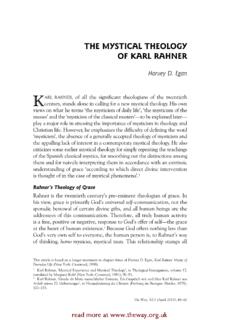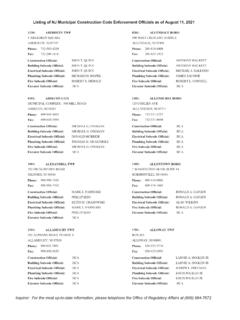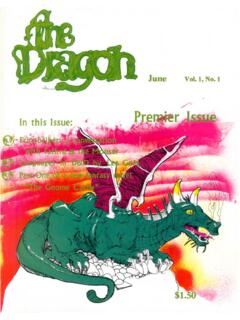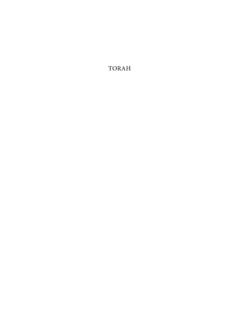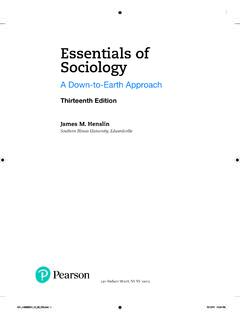Transcription of Standard Practice for Liquid Penetrant Testing1
1 Designation: E1417/E1417M 16 Standard Practice forLiquid Penetrant Testing1 This Standard is issued under the fixed designation E1417/E1417M; the number immediately following the designation indicates the yearof original adoption or, in the case of revision, the year of last revision. A number in parentheses indicates the year of last superscript epsilon ( ) indicates an editorial change since the last revision or Standard has been approved for use by agencies of the Department of Scope* This Practice establishes the minimum requirements forconducting Liquid Penetrant examination of nonporous metal,and nonmetal This Practice replaces The Penetrant examination processes described in thispractice are applicable to in-process, final, and maintenance(in-service) examinations.
2 These processes are applicable forthe detection of discontinuities, such as lack of fusion,corrosion, cracks, laps, cold shuts, and porosity, that are openor connected to the surface of the component under Caution must be exercised in the usage of elevatedtemperature with components manufactured from thermoplas-tic materials. Also, some cleaners, penetrants, and developerscan have a deleterious effect on nonmetallic materials such asplastics. Prior to examination, tests should be conducted toensure that none of the cleaning or examination materials areharmful to the components to be The values stated in either SI units or inch-pound units are to be regarded separately as Standard . Thevalues stated in each system may not be exact equivalents;therefore, each system shall be used independently of the values from the two systems may result in non-conformance with the All areas of this Practice may be open to agreementbetween the cognizant engineering organization and thesupplier, or specific direction from the cognizant Standard does not purport to address all of thesafety concerns, if any, associated with its use.
3 It is theresponsibility of the user of this Standard to establish appro-priate safety and health practices and determine the applica-bility of regulatory limitations prior to Referenced The following documents form a part of this Practice tothe extent specified Standards:2D95 Test Method for Water in Petroleum Products andBituminous Materials by DistillationD2512 Test Method for Compatibility of Materials withLiquid Oxygen (Impact Sensitivity Threshold and Pass-Fail Techniques)D6304 Test Method for Determination of Water in Petro-leum Products, Lubricating Oils, and Additives by Cou-lometric karl fischer TitrationE165 Practice for Liquid Penetrant Examination for GeneralIndustryE543 Specification for Agencies Performing NondestructiveTestingE1135 Test Method for Comparing the Brightness of Fluo-rescent PenetrantsE1316 Terminology for Nondestructive ExaminationsE2297 Guide for Use of UV-A and Visible Light Sources andMeters used in the Liquid Penetrant and Magnetic ParticleMethodsE3022 Practice for Measurement of Emission Characteris-tics and Requirements for LED UV-A Lamps Used inFluorescent Penetrant and Magnetic Particle Standards.
4 3 ANSI/ASNT-CP-189 Standard for Qualification and Certifi-cation of Nondestructive Testing PersonnelSNT-TC-1 ARecommended Practice for Personnel Qualifi-cation and Certification in Nondestructive Testing1 This Practice is under the jurisdiction of ASTM CommitteeE07on Nonde-structive Testing and is the direct responsibility of LiquidPenetrant and Magnetic Particle edition approved June 15, 2016. Published July 2016. Originallyapproved in 1991. Last previous edition approved in 2013 as E1417/E1417M : referenced ASTM standards, visit the ASTM website, , orcontact ASTM Customer Service at ForAnnual Book of ASTMS tandardsvolume information, refer to the Standard s Document Summary page onthe ASTM from American Society for Nondestructive Testing (ASNT), Box28518, 1711 Arlingate Ln.
5 , Columbus, OH 43228-0518, *A Summary of Changes section appears at the end of this standardCopyright ASTM International, 100 Barr Harbor Drive, PO Box C700, West Conshohocken, PA 19428-2959. United States1 Standards:4, 5 MIL-STD-792 Identification Marking Requirements forSpecial Purpose ComponentsQPL-AMS-2644 Qualified Products List, InspectionMaterial, PenetrantMIL-STD-45662 Calibration System Standards:6 ANSI/NCSL Z540-1 General Requirement for CalibrationLaboratories and Measuring Test EquipmentISO 10012 Measurement Management Systems Requirements for Measuring Measurement Process andMeasuring EquipmentNAS 410 Certification and Qualification of NondestructiveTest Standard :7 AMS 2644 Inspection Material, PenetrantAMS 2175 ACastings, Classification and Inspection Contracts Unless otherwise specified, the issuesof the documents that are DoD adopted are those listed in theissue of the DoDISS (Department of Defense Index of Speci-fications and Standards) cited in the of Precedence In the event of conflict betweenthe text of this Practice and the references cited herein, the textof this Practice takes The terminology relating to Liquid Penetrant examina-tion that appears in TerminologyE1316shall apply to the termsused in this of Terms Specific to This any component that will be installed on asystem that (CEO) Reference Terminology the part(s) or element(s)
6 Of a systemdescribed, assembled, or processed to the extent specified bythe examination the final examination performedfor the acceptance of the item. Any change to the item s surfacesuch as machining, grinding, welding, heat treatment, oretching by subsequent manufacturing operation, may renderthe previous examination invalid, requiring reexamination ofall affected surfaces, unless otherwise approved in the that which occurs during manufacturingbefore a component is in final refers to components that are in use orstorage for their intended indication Penetrant indications with at least athree to one length to width repeat, after cleaning, the application andappropriate processing of Penetrant , emulsifier (as required),and developer (as required). indication Penetrant indication whoselength to width ratio is less than the organization contracted to supply thematerial, parts, or engine critical components any componenton turbine engine designated by the manufacturer as critical.
7 4. Significance and This Practice establishes the basic parameters for con-trolling the application of the Liquid Penetrant method. Thispractice is written so it can be specified on the engineeringdrawing, specification, or contract. It is not a detailed how-toprocedure to be used by the inspector and, therefore, must besupplemented by a detailed procedure that conforms to therequirements of this Practice . SpecificationE165containsinformation to help develop detailed Penetrant examination processes and materials are clas-sified in accordance with the material classification containedin AMS 2644. Penetrant systems covered by this Practice shallbe of the following types, methods, and sensitivity I Fluorescent II Visible A Water B Post-emulsifiable, C D Post-emulsifiable, (These levels apply to Type I penetrantsystems only.)
8 Type II Penetrant systems have only a singlesensitivity and it is not represented by any of the levels listedas follows) Level1 2 Very Level 1 Level 2 Level 3 Level 4 Developers shall be of the following a Dry b c d Nonaqueous for Type I fluorescent e Nonaqueous for Type II visible f Specific Solvent removers shall be of the following 1 2 of specifications, standards, drawings, and publications required bymanufacturers in connection with specific acquisition functions should be obtainedfrom the contracting activity or as directed by the contracting from Standardization Documents Order Desk, DODSSP, Bldg. 4,Section D, 700 Robbins Ave., Philadelphia, PA 19111-5098, from American National Standards Institute (ANSI), 25 W. 43rd St.,4th Floor, New York, NY 10036, from SAE International (SAE), 400 Commonwealth Dr.
9 , Warrendale,PA 15096-0001, 162 3 Specific General for Examination Unless otherwisespecified in the contract or purchase order, the cognizantengineering organization is responsible for the performance ofall examination requirements as specified herein. The cogni-zant engineering organization may specify more stringentrequirements than the minimum specified in this Practice whennecessary to ensure that a component meets its functional andreliability requirements. Except as otherwise specified, thesupplier may utilize his own facilities or any other facilitiessuitable for the performance of the examination requirementsspecified herein. The purchaser reserves the right to performany of the examinations set forth in this Practice where suchexaminations are deemed necessary to ensure that supplies andservices conform to prescribed When examination is required in accor-dance with this Practice the orders, contracts, or other appro-priate documents shall specify the criteria by which theacceptability of components is to be evaluated.
10 Engineeringdrawings or other applicable documents shall indicate theacceptance criteria for the entire component; zoning may beused. Examination on a sampling basis shall not be allowedunless specifically permitted by the Qualification Personnel performing exami-nations to this Practice shall be qualified and certified inaccordance with ASNT Personnel Qualification SNT-TC-1A,ANSI/ASNT-CP-189 or NAS 410 for military purposes, or asspecified in the contract or purchase Qualification The agency performing thispractice may be evaluated in accordance with Materials Only materials listed or ap-proved for listing on QPL-AMS-2644 (reference AMS 2644)shall be utilized for Penetrant examination. Materials notconforming to the requirements of AMS 2644 may be usedonly when a waiver is obtained from the cognizant Oxygen (LOX) Compatible Materials Penetrant materials tested in accordance with Test MethodD2512and passing at 70 ft lbf [95 J] or higher, shall be used onLOX wetted surfaces that cannot be thoroughly of these materials shall be in accordance with the materialsupplier instructions and shall require approval of the cogni-zant engineering organization when such materials do not meetthe requirements of AMS and Facilities Processing equipment usedin the Penetrant examination process shall be constructed andarranged to permit a uniform and controlled operation.


